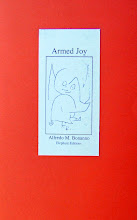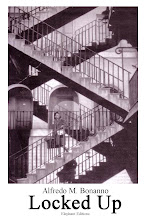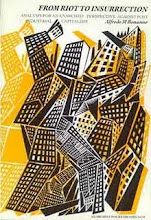From Insurrection Issue Four, May 1988
Trade unionism is in its decline. In good as in evil with this structural form of struggle an era is disappearing, a model and a future world seen in terms of an improved and corrected reproduction of the old one.
We are moving towards new and profound transformations. In the productive structure, in the social structure.
Methods of struggle, perspectives, even short term projects are also transforming.
In an expanding industrial society the trade union is moving from instrument of struggle to instrument supporting the productive structure itself.
Revolutionary syndicalism has also played its part: pushing the most combative workers forward but, at the same time, pushing them backwards in terms of capacity to see the future society or the creative needs of the revolution. Everything remained parceled up within the factory dimension. Workerism is not just common to authoritarian communism. Singling out privileged areas of the class clash is still today one of the most deep-rooted habits that it is difficult to lose.
The end of trade-unionism therefore. We have been saying so for fifteen years now. At one time this caused criticism and amazement, especially when we included anarcho-syndicalism in our critique. We are more easily accepted today. Basically, who does not criticise the trade unions today? No one, or almost no one.
But the connection is overlooked. Our criticism of trade unionism was also criticism of the "quantitative" method that has all the characteristics of the party in embryo. It was also a critique of the specific organisations of synthesis. It was also a critique of class respectability borrowed from the bourgeoisie and filtered through the cliches of so-called proletarian morals. All that cannot be ignored.
If many comrades agree with us today in our now traditional critique of trade-unionism those who share a view of all the consequences that it gives rise to we but a few.
We can only intervene in the world of production using means that do not place themselves in the quantitative perspective. They cannot therefore claim to have specific anarchist organisations behind them working on the hypothesis of revolutionary synthesis.
This leads us to a different method of intervention, that of building factory "nuclei" or zonal "nuclei" which limit themselves to keeping in contact with a specific anarchist structure, and are based exclusively on affinity. It is from the relationship between the base nucleus and specific anarchist structure that a new model of revolutionary struggle emerges to attack the structures of capital and the State through recourse to insurrectional methods.
This allows for a better following of the profound transformations that are taking place in the productive structure. The factory is about to disappear, new productive organisations are taking its place, based mainly on automation. The workers of yesterday will become partially integrated into a supporting situation or simply into a situation of social security in the short-term, survival in the long one. New forms of work will appear on the horizon. Already the classical workers' front no longer exists. Like-wise the trade union, as is obvious. At least it no longer exists in the form in which we have known until now. It has become a firm like any other.
A network of increasingly different relations, all under the banner of participation, pluralism, democracy, etc, will spread over society bridling almost all the forces of subversion. The extreme aspects of the revolutionary project will be systematically criminalised.
But the struggle will take new roads, will filter towards a thousand new sub-terranean channels, emerging in a hundred thousand explosions of rage and destruction, with new and incomprehensible symbolism.
As anarchists we must be careful, we carriers of an often heavy mortgage from the past, not to remain distanced from a phenomenon that we end up not understanding and whose violence could one fine day even scare us. And in the first case we must be careful to develop our analysis in full.
skip to main |
skip to sidebar

Some writings of Alfredo Maria Bonanno in English, or almost

Alfredo Bonanno was arrested on October 1st 2009 in Greece, accused of concourse in robbery. With him, anarchist comrade Christos Stratigopoulos.
Here are a few translations and part translations of a small portion of Alfredo's writing. This is a work in progress, many of the translations are as yet incomplete. Open links to find more of Alfredo's work.
Alfredo Bonnano Released
Nov. 22 Alfredo Bonnano was sentenced to 4 years imprisonment (which practically means that with the time served so far and the fact that he is over 70years old HE IS RELEASED
Christos Stratigopoulos (who took responsibility for the action)
was sentenced to 8 years and 9 months with the Greek law will probably be released at the end 2011
BY ANY MEANS NECESSARY
LINKS
click on any of these labels to read text
- "Community" sickness
- 1981 - Editorial
- A Critique of Syndicalist Methods
- A few notes on Sacco and Vanzetti
- A few notes on the revolutionary movement in Italy
- A little man in Singapore
- A million jobs
- A question of class
- Affinity
- After Marx autonomy
- Albania Laboratory of Subversion (Introduction)
- Anarchism and the national liberation struggle
- Anarchists and action
- AND WE WILL ALWAYS BE READY TO STORM THE HEAVENS AGAIN (Against amnesty)
- ANTI-INSTITUTIONAL MOVEMENT
- Are we modern?
- Armed Joy
- ARMED STRUGGLE. SOME REFLECTIONS.
- Autonomous base nuclei
- beyond syndicalism
- Beyond workerism
- But what is the imaginary?
- Class War
- Comiso - Organizational document of the self-managed leagues
- Considerations on illegality
- Dissonances (Introduction)
- Elephant Editions 1986
- Excluded and included
- Farewell to claiming
- Feral Revolution (Introduction)
- FICTITIOUS MOVEMENT AND REAL MOVEMENT
- For an Antiauthoritarian Insurrectionist International - Proposal for a debate
- From riot to insurrection
- From the centre to the periphery
- Good technology
- Guerilla Extraordinary
- Habits and idols
- Hegel
- I know who killed chief superintendent Luigi Calabresi
- Illegality
- Illness and capital
- Informal organisation
- Insurrection
- Internationalism
- Introduction to Sabate
- Introduction to Anarchism and Violence
- Introduction to Bratach Dubh English edition of Malatesta's Fra Contadini
- Introduction to Insurrectionalist Anarchism
- Introduction to Strange Victories
- Introduction to The Conquest of Bread
- Involuntary aspects of voluntary work
- Let's destroy work
- LET'S DESTROY WORK. New introduction
- Let's keep our feet on the ground please
- Lightening Conductors and Stand-ins - more shots of non-news
- Lightning Conductors and Stand-ins
- Lightning Conductors and Stand-ins (cont.)
- Locked up
- Looking forward to self-management
- Loss of language
- More on internationalism
- National Liberation Struggle
- nineteen years on
- No more crises
- Non-news about drugs
- Non-news about racism
- Ode to the Uniform
- On Feminism
- One's life on the line
- Order and chaos
- Otto Ruhle (Introductory Note)
- OUR ROLE IN THE PRESENT CONFLICT
- Palestine mon amour
- Pantagruel anarchist review
- Pinelli
- Prison and Prisoners’ Struggles - Introduction
- Propulsive Utopia
- Quality and the factory
- Restructuring Capital and the new democracy
- Revolution - Violence - Antiauthoritarianism
- REVOLUTIONARY VIOLENCE
- Science and the social revolution
- Self-management
- Severino Di Giovanni in Argentina 1923-1931 by Osvaldo Bayer
- Social banditry
- SOME NOTES -
- Space and Capital
- Stirner
- Stop the City? From information to attack
- Strategy and Methods
- Streamlined production
- The "end" of the crisis
- The aesthetics of anarchism
- The anarchist tension
- The area of autonomy and the anarchist movement in Italy
- The armed wing of science
- The Cruise missile base at Comiso can be prevented
- The ethical bank
- The insurrectional project
- THE LANGUAGE OF TECNICS -
- The logic of insurrection
- The moral split
- THE NECESSARY DESTRUCTION -
- The priority of practice
- The refusal of arms
- The revolutionary project
- The revolutionary struggle
- The significance of an insignificant event
- The struggle for self-managed social space
- The tyranny of weakness
- The whole and the part
- The young in a post industrial society
- Theory and action
- Towards anarchist antimilitarism
- TOWARDS THE GENERALISATION OF ARMED STRUGGLE
- TRANSFORMATION IN THE WORLD OF WORK AND SCHOOL -
- TRUTH -
- Unemployment in Italy - How come everything doesn't explode?
- Untitled
- Violence and non-violence
- What are anarchists
- What can we do with anti-fascism?
- Why a vanguard?
- Why Insurrection
- World domination in a few words











